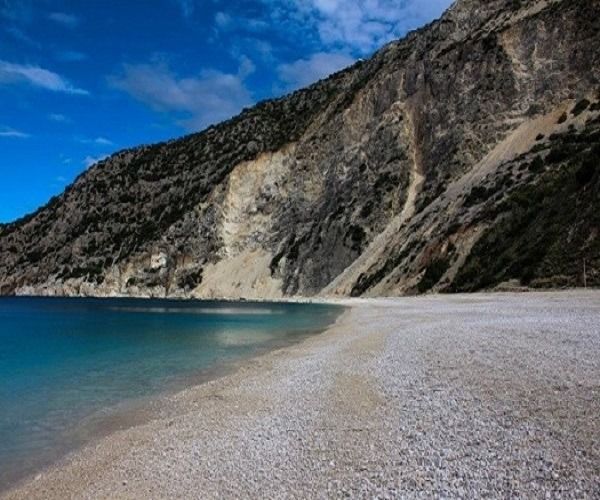
Now that summer travel is approaching, here are five Greek Islands to vacation to when it is safe to flock to Greece.
Kefalonia
Unblemished Kefalonia is Greece’s fifth-largest island. Until the mid-nineties, it remained concealed in the lesser-traveled Ionian Sea. It became romanticized in 1994 novel by Britsh author Louis de Bernieres – Captain Corelli’s Mandolin, about Italian soldiers invading Greece during the second world war—later showcased in the silver screen adaptation starring Nicolas Cage and Penelope Cruz.
Its seaside mesmerizes travelers. Its crown-jewel beach is the turquoise- aquamarine-colored waters of Myrtos regularly lauded as a top 10 beach in the world. The seductive stretch of sand flanked by high limestone walls shimmers as the sun radiates off its translucent waters.
Cave excavators marvel at Melissani Cave and lake combining freshwater and sea-water. It’s two caves in one. While one remains lit by the sun, the other darkened, mysterious, and covered in stalagmites. During mid-day, when the sun shines directly above, letting direct light creates a glowing illusion in its turquoise waters.
Picturesque harbor front villages of Fiscardo, Assos with its Venetian Castle of Agios Georgios, and Sami overlook quaint fishing trolleys and lined with seaside dining captivate all who delve to Greece’s less-traveled Ionian islands.
Despite the bustle of summer sojourners, the lush and mountain island is plenty big for exploration. The best way to traverse the varied island is by renting a car in the vibrant capital of Argostoli Town.
No boats depart from the Athens port of Piraeus. Most visitors to the island arrive by daily ferries from the Peloponnese city of Patras to the port of Poros. Ferries connect neighboring Ionian islands of Zakynthos, Ithaca, Killini, and Lefkada to Kefalonia. In the summertime, ships also operate from Brindisi in Italy. Its international airport accommodates daily flights from Athens and charter flights from European capitals.
Kimolos
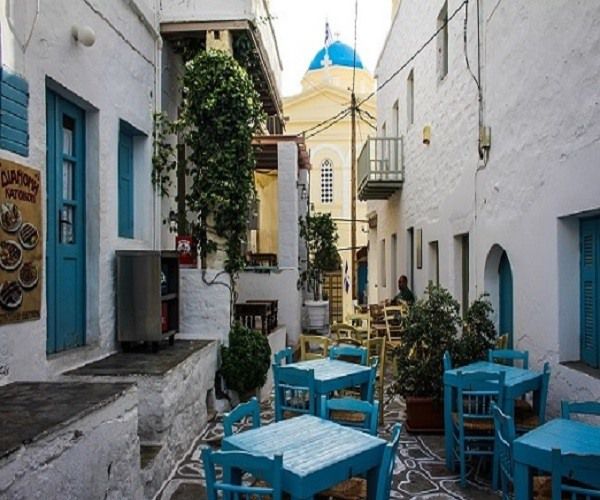
The allure of Kimolos Island is that time appears to be frozen. It feels like Kimolians live like the way the Cyclades were 30 years ago. Although a stone’s throw from much grander Milos, few vacationers escape to the road less traveled island. Today, the snail-pace land remains one of the Aegean’s most undiscovered treasures.
Kimolos is the polar opposite of raucous Mykonos or the hordes of caldera gawking tourists who swarm upon overrun Santorini. Greek Island-hoppers come to this lovely island sanctuary to immerse with locals whose genuine-quaint hospitality is apparent from the moment you depart the ferry at the port of Psathi. There are at least 15 lovely beaches to bathe some sounded by sequestered coves. See local life in picturesque fishing villages, where tiny boats dot the bay, while time-honored locals discuss the days catch.
Getting too far away or lost is not an option. All roads eventually lead back to the one village and capital of Chorio, pronounced “Horio” and the Kastro or Castle, a fortress within the confines of the island’s enclave.
Yet, the island of 38 Kilometers (around 23 miles to circumnavigate the tiny island), holds impressive peaks and valleys perfect for hiking.
There are enough beaches to suit all tastes. Another highlight is the Gerakias cave. Dive into the sparkling waters, and walk its shallow waters inside the cave.
For the perfect ending to any day on Kimolos Island, take a drive to Ellinika Beach for its impressive sunsets, and marvel at the spellbinding rock formations straight out at the sea of Aspragremna there are remains and wreckages of the ancient city of Kimolos as well as the ancient tombs. Hike to Skiadi rock, a peculiar boulder shaped in the form of a giant mushroom.
Kimolos, located in the southwest Cyclades chain of stellar islands, is around 90 miles due south of Athens. Boats leave from Athens port of Piraeus for the longer 7-8 hour journey as the ferries stop along the way at other islands. The 20-minute short crossing from Milos operates 5-7 times per day. Besides service from Milos, well-traveled islands of Kythnos, Serifos, and Sifnos. As Milos has an airport, you can fly into Milos and catch the launch over to Kimolos.
Milos
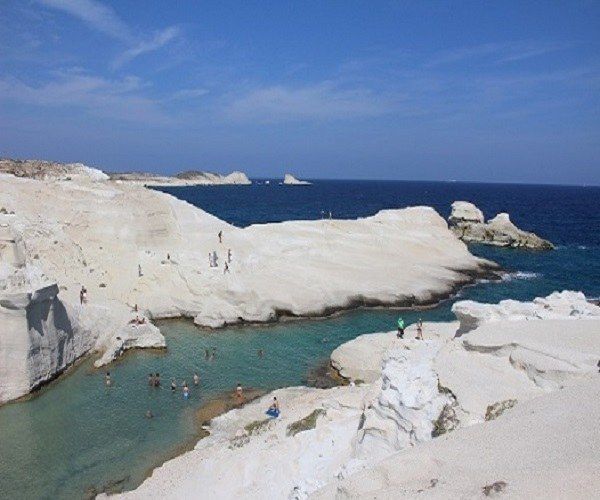
It’s mind-boggling that volcanic Milos has remained on the road less traveled, far-flung from the hordes of sunseekers that flock it’s fashionable Cyclades neighbors attract.
The flawless irregular formed gem of Milos is a geological marvel sculpted from years of eruptions at sea three million years ago, rain, and wind. Its rock formations are out of this world. It contains vast mineral deposits, including the clay types of bentonite and kaolin. The private hideaway has plenty of watering holes with over 70 beaches.
Each nook and crazy on Milos has a beach. Highlights include the alabaster lunarscape rocks of Sarakiniko, which gives the appearance of walking on the moon. Sit’s an ideal stop for kayaking and cave exploration.
The scorching multi-colored sand of Paleochori lined with beach bars and tavernas is a lazy way to spend a day. Papafragas, submerged in a cave enclosed by soft white rocks in deep blue waters, is another oddly formed swimming spot. To arrive at
hidden Tsigrado, you must climb down a ladder or swim in.
Beachgoers should seek Paliochori, with its crystal-clear waters, multi-colored sand and shiny pebbles, and Papafragas, submerged in a cave enclosed by soft white rocks in deep blue waters.
The best way to catch a glimpse of life on the rocks is by boat excursions that depart out of the port of Adamas. Among the most impressive highlights of a day sailing trip are the towering rock slabs at the ex-pirate den of Kleftiko, where you spend an hour for lunch and snorkeling. The brightly colored fisherman cottages in Klima is another magnificent spot on Milos.
There are daily flights in the high season from Athens to Milos Airport, and year-round ferry service from the port of Piraeus. The journey takes four hours on the high-speed boats or up to eight hours and regular ferries that make stopovers at other islands. Milos has excellent connections from most neighboring islands in the Cyclades.
Serifos
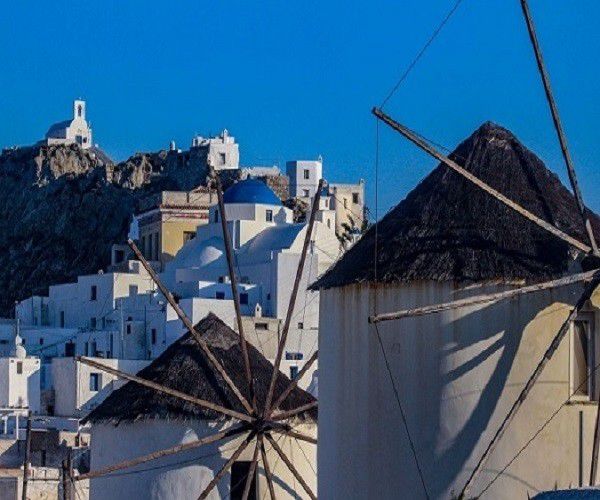
The island of Serifos is as far from the glitz and glamour of Santorini and Mykonos as possible. Entering the picturesque port of Livadi dotted with rows of irresistible fish tavernas sitting in the sand is taking a step back to undisturbed tranquil times of the Cyclades in the 70s or 80s when the island was off the grid to ferry-hoppers. The pier faces the chiseled mountaintop glancing at the capital of Hora. The enclave bustles in the summer.
From the mesmerizing cobblestone streets of Chora town’s precipitous towering mountainous backdrop, the aquamarine port and bay below shimmer in the radiant sunlight. In the prominent hamlet, the stellar Venitian Castle looms extensive offer eye-popping views of the Aegean Sea, and a kaleidoscope of colors burst into the evening during sunset.
Today, Serifos’ languid pace lures its fair amount of Cylade explorers. Yet, the Serifians have managed to keep their culture intact, and thus, draw visitors seeking an unhurried Greek escape.
Its undiscovered rugged beauty and open spaces likened to California’s central coast, or perhaps the Ventura Highway contains many jaw-dropping vistas leading to pebble beaches. It’s bluffs, peaks, and cliffs make the Aegean.
Located in the northern center of the island is the divine fortress-like Monastery of Taxiarches. Built-in 1572, the men’s monastery assigned to the island patron saints are Gabriel, and Michael is a must-visit. The sleepy beach of Mega Livadi sits in the shade under tamarisk trees. The shallow bay and cove perfect for families with small children.
Strolling the Serifos harbor at night is the quintessential Cyclades exposure.
Serifos is a comfortable two-hour ferry ride from the Piraeus port of Athens. Due to its growing popularity, the island connected to neighboring Kythnos, Milos, and Sifnos is optimum for a 3-4 island journey.
Sifnos
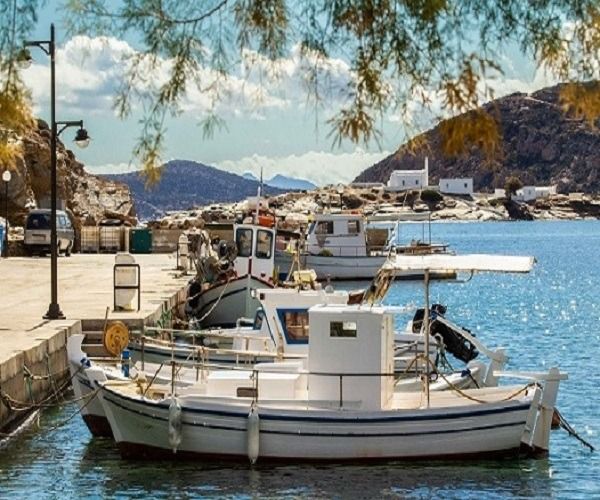
The chiseled masterpiece of Sifnos, brimming with olive trees, fragrant capers creeping out from rock beds, wild sage, oregano, and thyme, which grows throughout the mountainous isle and its fertile valleys has astounded Greek-Island hoppers for decades. The time-honored Greek Orthodox religion found at nearly 400 churches that dot the landscape.
The island crowning monument is the beautifully preserved mountain top ruins of the Agios Andreas Acropolis & Museum and adjacent church. Although newly excavated in the early 20th century, it’s inception dates back to the 13th century. The stunning Church of the Seven Martyrs reaches to the edge of the Aegean Sea.
The islands’ time-honored craft of pottery making dates back to the Cycladic period, and there are currently 19 pottery workshops on the island.
While no longer a best-kept secret, the island home of native son, poet, and culinary icon Nikos Tselementes and other master chefs are renowned throughout Greece for its gastronomy. Aromatic whiffs of mastelo, the customary dish of lamb cooked in red wine and dill baked in clay ovens, is a Sifnos delicacy.
The modest island of countless hidden churches and over 50 ancient towers is a hikers paradise. The old town of Kastro is a well-preserved treasure and a step back in time inhabited for more than 3,000 years. The ancient settlement filled with antiquities allows no cars inside the village maze.
Sifnos is under three hours from Athens by high-speed ferry and offers an enticing blend of traditional Greek life, combined with some of the best sun-splashed beaches in all of Greece.
By Nick Kontis
